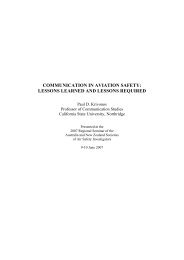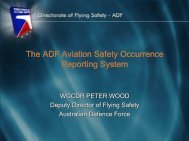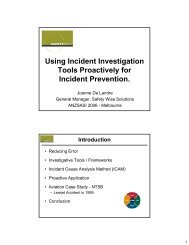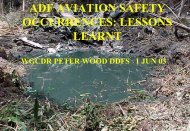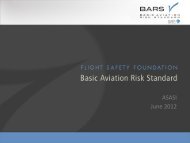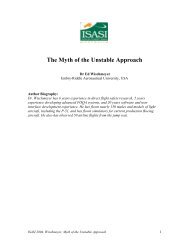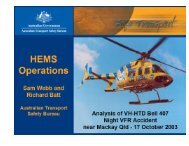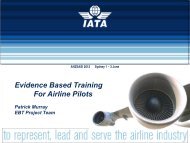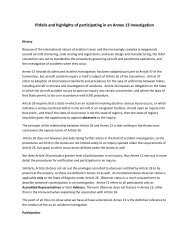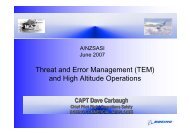Using Incident Investigation Tools Proactively for Incident ... - ASASI
Using Incident Investigation Tools Proactively for Incident ... - ASASI
Using Incident Investigation Tools Proactively for Incident ... - ASASI
Create successful ePaper yourself
Turn your PDF publications into a flip-book with our unique Google optimized e-Paper software.
_____________________________________________________________________<br />
The NTSB (2005) noted the challenges and difficulties with the investigation by stating:<br />
“This investigation took 13 months to complete and was hampered by several factors:<br />
- Because the aircraft impacted at nearly supersonic speed and at an extremely steep<br />
angle, none of its components remained intact. There<strong>for</strong>e, investigators had to<br />
painstakingly examine the fragmented valves, connectors, and portions of other<br />
aircraft parts be<strong>for</strong>e they could draw any conclusions about the accident's cause.<br />
- The airplane was not equipped with a flight data recorder, an invaluable tool in most<br />
major investigations, and it had only a 30-minute cockpit voice recorder, which was<br />
of limited use during this investigation.<br />
- And, all of the investigators involved in this investigation were also investigating<br />
other accidents. The Investigator-in-Charge was working on four other investigations<br />
in addition to this one.”<br />
APPLICATION OF ICAM TO THE CASE STUDY<br />
Absent / Failed Defences<br />
Absent or failed defences are those contributing factors that failed to detect and protect the<br />
system against technical and human factors. These are the control measures that did not<br />
prevent the incident or limit its consequences. Some of the Absent / Failed Defences<br />
identified in the accident included:<br />
- Cabin pressurisation (inability to maintain)<br />
- Bleed air supply to the cabin (lack of)<br />
- Flow control valve - supplying warm air to windshield (closed)<br />
- Timeliness/warning <strong>for</strong> donning oxygen masks (adequacy )<br />
- Oxygen quality/quantity<br />
- Incomplete standardised manual and procedures<br />
- Ambiguous maintenance procedures, some verbal, some written, some not signed<br />
off.<br />
- Poor written reporting relationship between aircrew and maintenance staff<br />
- Non adherence to company policy <strong>for</strong> maintenance reporting/signoff<br />
- Inadequate procedures <strong>for</strong> emergency oxygen supply<br />
- Unclear whether guidance provided <strong>for</strong> procedures anomaly – switching to auto<br />
pilot<br />
- Procedures <strong>for</strong> reporting maintenance issues inadequate<br />
- Written records <strong>for</strong> maintenance reports incomplete<br />
- Application of SOP’s (previous inconsistencies)<br />
- Crew pairing (Inexperienced Captain with First Officer)<br />
- Flying time on type (Captain limited)<br />
Individual / Team Actions<br />
Individual / Team Actions are the errors or violations that led directly to the incident. They<br />
are typically associated with personnel having direct contact with the equipment, such as<br />
operators or maintenance personnel. They are always committed actively (someone did or did<br />
not do something) and have a direct relation with the incident. Some of the Individual / Team<br />
Actions identified in the accident included:<br />
___________________________________________________________________________________<br />
~ ANZSASI 2006 : De Landre, Gibb and Walters ~<br />
Page 8 of 12



